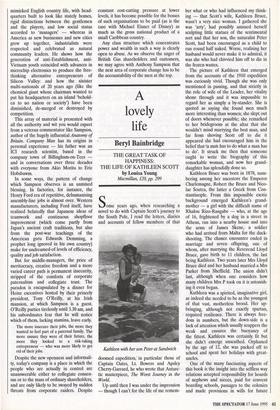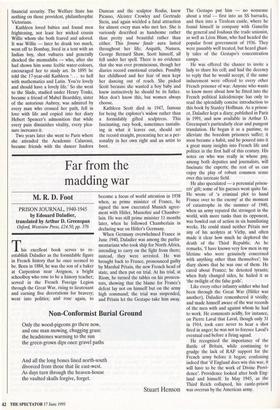A lovely life
Beryl Bainbridge
THE GREAT TASK OF HAPPINESS: THE LIFE OF KATHLEEN SCOTT by Louisa Young Macmillan, £20, pp. 299 Some years ago, when researching a novel to do with Captain Scott's journey to the South Pole, I read the letters, diaries and accounts of fellow members of that Kathleen with her son Peter at Sandwich doomed expedition; in particular those of Captain Oates, Lt. Bowers and Apsley Cherry-Garrard, he who wrote that Antarc- tic masterpiece, The Worst Journey in the World.
Up until then I was under the impression — though I can't for the life of me remem- ber what or who had influenced my think- ing — that Scott's wife, Kathleen Bruce, wasn't a very nice woman. I gathered she was 'arty', had possibly amused herself sculpting little statues of the sentimental sort and that her son, the naturalist Peter Scott, had been encouraged as a child to run round half naked. Worse, realising her husband would never make it to admiral, it was she who had chivvied him off to die in the frozen wastes.
The picture of Kathleen that emerged from the accounts of the 1910 expedition was curiously vivid. Though she was only mentioned in passing, and that strictly in the role of wife of the Leader, her vitality shone through and it was impossible to regard her as simply a by-stander. She is quoted as saying she found men much more interesting than women; she slept out of doors whenever possible; she remarked to her bridegroom at the altar that she wouldn't mind marrying the best man, and far from shoving Scott off to die it appeared she had encouraged him in the belief that 'a mat► has to do what a man has to do'. It struck me then that someone ought to write the biography of this remarkable woman, and now her grand- daughter has splendidly done so.
Kathleen Bruce was born in 1878, num- bering among her ancestors the Emperor Charlemagne, Robert the Bruce and Nico- lae Soutza, the latter a Greek from Con- stantinople. From this impossible exotic background emerged Kathleen's grand- mother — a girl with the difficult name of Rhalou Rizo-Rangabe — who, at the age of 16, frightened by a dog in a street in Athens, ran into a nearby house and into the arms of James Skene, a soldier who had arrived from Malta for the duck- shooting. The chance encounter ended in marriage and seven offspring, one of whom, after marrying the Reverend Lloyd Bruce, gave birth to 11 children, the last being Kathleen. Two years later Mrs Lloyd Bruce died and her husband married a Mrs Parker from Sheffield. The union didn't last, although when one considers how many children Mrs P took on it is astonish- ing it even began.
Kathleen was a spirited, imaginative girl, as indeed she needed to be as the youngest of that vast, motherless brood. Her up- bringing, although not exactly spartan, required resilience. There is always free- dom in numbers, but the down-side is a lack of attention which usually scuppers the weak and ensures the buoyancy of the fittest. Kathleen was certainly fit but she didn't emerge unscathed. Orphaned by the age of 12, she was packed off to school and spent her holidays with great- uncles.
One of the many fascinating aspects of this book is the insight into the selfless way relations accepted responsibility for hoards of nephews and nieces, paid for convent boarding schools, passages to the colonies and made provisions in wills for future
financial security. The Welfare State has nothing on those provident, philanthrophic Victorians.
Kathleen loved babies and found men frightening, not least her wicked cousin Willie whom she both feared and adored. It was Willie — later he drank too much, went off to Bombay, lived in a tent with an Indian boy, shot vultures and generally shocked the memsahibs — who, after she had shown him some feeble water-colours, encouraged her to study art. In 1895 he told the 17-year-old Kathleen `. . to hell with mathematics and Latin. You're lovely and should have a lovely life.' So she went to the Slade, studied under Henry Tonics, became a friend of Mabel Beardsley, sister of the notorious Aubrey, was admired by every man who crossed her path, fell in love with life and copied into her diary Hebert Spencer's admonition that while every pain diminishes vitality, every plea- sure increases it.
Two years later she went to Paris where she attended the Academie Calarossi, became friends with the dancer Isadora
Duncan and the sculptor Rodin, knew Picasso, Aleister Crowley and Gertrude Stein, and again wielded a fatal attraction for almost every man who met her. She is variously described as handsome rather than pretty and beautiful rather than either. This femme fatale aura lasted throughout her life; Asquith, Nansen, George Bernard Shaw, Scott himself, all fell under her spell. There is no evidence that she was ever promiscuous, though her diaries record emotional crushes. Possibly her childhood and her fear of men kept her dancing out of reach. She picked Scott because she wanted a boy baby and knew instinctively he should be its father. Men don't know this, but women always choose.
Kathleen Scott died in 1947, famous for being the explorer's widow rather than a formidably gifted sculptress. This fascinating, racy book, sometimes tantalis- ing in what it leaves out, should set the record straight, presenting her as a per- sonality in her own right and an artist to boot.



































































 Previous page
Previous page